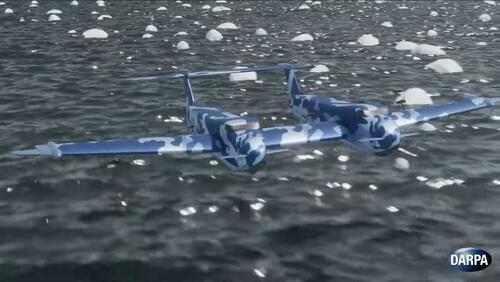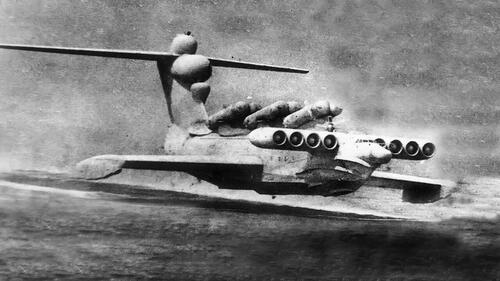
The Pentagon's top research agency has unveiled a highly unusual kind of plane that is a blend between a hovercraft and an aircraft to skim the ocean's surface to deliver cargo much faster than convention transport vessels.
Defense Advanced Research Projects Agency's (DARPA) "Liberty Lifter" uses a trick of physics known as the "ground effect" to reduce aerodynamic drag by only flying no more than the length of its wingspan above water. This allows the plane to travel much faster and carry large amounts of payload.
Liberty Lifter "will combine fast and flexible strategic lift of very large, heavy loads with the ability to take off/land in water," DARPA said in the press release.
The agency pointed out the Soviet Union developed a ground-effect vehicle called ekranoplans, explaining that "these vehicles were high speed and runway- independent, but were restricted to calm waters and had limited maneuverability."
Ekranoplans was designed in 1975 and used by the Soviets in the late 1980s through the 90s. Only three Orlyonok-class ekranoplans were operational and flew 13 feet above the water at a top speed of 342 mph. They were nicknamed the "Caspian Sea Monster" and were only limited to good weather and calm seas. All three were retired by the late 1990s.
DARPA's Liberty Lifter appears to be an evolution of the ekranoplans and can operate in rough conditions or even sustained flight at mid-altitudes, something the Soviets could never achieve.
"This first phase of the Liberty Lifter program will define the unique seaplane's range, payloads, and other parameters.
"Innovative advances envisioned by this new DARPA program will showcase an X-plane demonstrator that offers warfighters new capabilities during extended maritime operations," said Alexander Walan, a program manager in DARPA's Tactical Technology Office.
Watch a simulation of Liberty Lifter below:
The Pentagon’s top research agency has unveiled a highly unusual kind of plane that is a blend between a hovercraft and an aircraft to skim the ocean’s surface to deliver cargo much faster than convention transport vessels.
Defense Advanced Research Projects Agency’s (DARPA) “Liberty Lifter” uses a trick of physics known as the “ground effect” to reduce aerodynamic drag by only flying no more than the length of its wingspan above water. This allows the plane to travel much faster and carry large amounts of payload.
Liberty Lifter “will combine fast and flexible strategic lift of very large, heavy loads with the ability to take off/land in water,” DARPA said in the press release.
The agency pointed out the Soviet Union developed a ground-effect vehicle called ekranoplans, explaining that “these vehicles were high speed and runway- independent, but were restricted to calm waters and had limited maneuverability.”
Ekranoplans was designed in 1975 and used by the Soviets in the late 1980s through the 90s. Only three Orlyonok-class ekranoplans were operational and flew 13 feet above the water at a top speed of 342 mph. They were nicknamed the “Caspian Sea Monster” and were only limited to good weather and calm seas. All three were retired by the late 1990s.
DARPA’s Liberty Lifter appears to be an evolution of the ekranoplans and can operate in rough conditions or even sustained flight at mid-altitudes, something the Soviets could never achieve.
“This first phase of the Liberty Lifter program will define the unique seaplane’s range, payloads, and other parameters.
“Innovative advances envisioned by this new DARPA program will showcase an X-plane demonstrator that offers warfighters new capabilities during extended maritime operations,” said Alexander Walan, a program manager in DARPA’s Tactical Technology Office.
Watch a simulation of Liberty Lifter below:
[embedded content]






